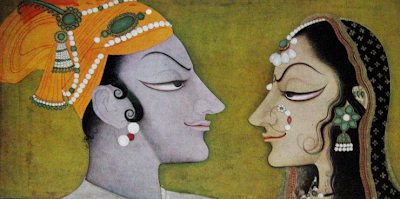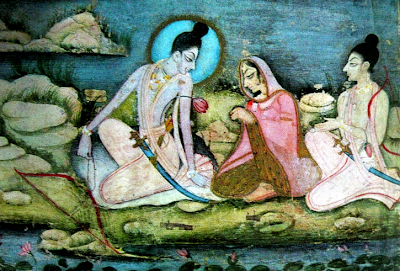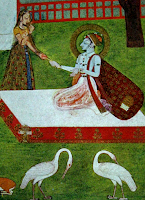 1.
1.All great art owes to the inspiration of religion. When spring comes, trees burst into blossoms. What spring is to the trees, inspiration is to human race. All creative art activity, such as architecture, sculpture, painting, poetry and music is an expression of spiritual joy felt by sensitive people.
A great art was born in the wake of Buddhism. The cave temples of Ajanta were decorated with paintings of sublime beauty. In Central Asia, China and Japan, Buddhism sparked a great art movement which inspired the construction of beautiful pagodas, gardens of peace and calm, poetry and painting. In Java, Buddhism inspired the construction of the greatest sculpture gallery of the world, the temple of Borobuddhur.
The inspiration of Islam gave birth to the noble mosques of Cordoba, Cairo, Baghdad and Isfahan. Their graceful domes and minarets decorated with tiles of great beauty, commune with heaven and indicate how love for beauty burst out, even from an austere faith which forbade sculpture and painting (when made for worship purpose).
Christianity inspired the sublime architecture of the Gothic cathedrals of Chartres, Amiens, Rhiems and Milan, and the great paintings of Leonardo da Vinci, Raphael, Giotto and Coreggio.
Similarly the beautiful religion of Love in India, that is the cult of Sri Krishna as well as sufi influences inspired the great paintings of Kishangarh.
2.
Founded in 1597, the town of Kishnagarh is famous for its finest school of miniature paintings in the 18th century. Kishnagarh is only 27km away from Ajmer which is the famous town where the celebrated sufi saint Khwaja Mu'inuddin Chishti's body is laid to final rest and hence a sacred site of pilgrimage. What makes the miniature paintings of Kishangarh distinct is that they are specially influenced by two Religious School of Love: Vaishnavite and Sufism.
According to many historians, Indian paintings began in the caves of Ajanta and evolved into the Pala and Jain styles. During early sixteenth century the Persian infusion came into play. Under the patronage of Akbar there was a true cultural cross-fertilization between the Persian techniques and India tradition, and a style of painting known as Mughal, whcih is truly Indian in spirit, evolved.
The beauty of Rajput paintings (Kishnagarh belongs to such school) is greatly inspired by the love of Radha, Krishna and the mythical human lover between them transcend itself to become divine love.
A. K. Coomaraswamy, mystic, scholar and historian while commenting on Kishangarh painting wrote: "Such paintings must always intimately appeal to those who are attracted by Indian life and thought, and above all to those who realize that they form the last visual records of an order that is rapidly passing away never to return.
In any case, this ethos is unique; what Chinese art achieved for landscape is here accomplished for human love. The arms of lovers are about each others neck, eye meets eye, the whispering Sakhis speak of nothing else but the course of Krishna's courtship, the very animals are spellbound by the sound of Krishna's flute and the elements stand still to hear the ragas and raginis. This art is only concerned with the realities of life; above all, with passionate love service, conceived as the symbol of all union. Rajput art creates a magic world where all men are heroic, all women are beautiful, passionate and shy, beast both wild and tame are friends of man and trees and flowers are conscious of the footsteps of the bridegroom as he passes by. This magic world is not unreal or fanciful, but a world of imagination and eternity, visible to all who do not refuse to see with the transfiguring eyes of love."
A great art was born in the wake of Buddhism. The cave temples of Ajanta were decorated with paintings of sublime beauty. In Central Asia, China and Japan, Buddhism sparked a great art movement which inspired the construction of beautiful pagodas, gardens of peace and calm, poetry and painting. In Java, Buddhism inspired the construction of the greatest sculpture gallery of the world, the temple of Borobuddhur.
The inspiration of Islam gave birth to the noble mosques of Cordoba, Cairo, Baghdad and Isfahan. Their graceful domes and minarets decorated with tiles of great beauty, commune with heaven and indicate how love for beauty burst out, even from an austere faith which forbade sculpture and painting (when made for worship purpose).
Christianity inspired the sublime architecture of the Gothic cathedrals of Chartres, Amiens, Rhiems and Milan, and the great paintings of Leonardo da Vinci, Raphael, Giotto and Coreggio.
Similarly the beautiful religion of Love in India, that is the cult of Sri Krishna as well as sufi influences inspired the great paintings of Kishangarh.
2.
Founded in 1597, the town of Kishnagarh is famous for its finest school of miniature paintings in the 18th century. Kishnagarh is only 27km away from Ajmer which is the famous town where the celebrated sufi saint Khwaja Mu'inuddin Chishti's body is laid to final rest and hence a sacred site of pilgrimage. What makes the miniature paintings of Kishangarh distinct is that they are specially influenced by two Religious School of Love: Vaishnavite and Sufism.
According to many historians, Indian paintings began in the caves of Ajanta and evolved into the Pala and Jain styles. During early sixteenth century the Persian infusion came into play. Under the patronage of Akbar there was a true cultural cross-fertilization between the Persian techniques and India tradition, and a style of painting known as Mughal, whcih is truly Indian in spirit, evolved.
The beauty of Rajput paintings (Kishnagarh belongs to such school) is greatly inspired by the love of Radha, Krishna and the mythical human lover between them transcend itself to become divine love.
A. K. Coomaraswamy, mystic, scholar and historian while commenting on Kishangarh painting wrote: "Such paintings must always intimately appeal to those who are attracted by Indian life and thought, and above all to those who realize that they form the last visual records of an order that is rapidly passing away never to return.
In any case, this ethos is unique; what Chinese art achieved for landscape is here accomplished for human love. The arms of lovers are about each others neck, eye meets eye, the whispering Sakhis speak of nothing else but the course of Krishna's courtship, the very animals are spellbound by the sound of Krishna's flute and the elements stand still to hear the ragas and raginis. This art is only concerned with the realities of life; above all, with passionate love service, conceived as the symbol of all union. Rajput art creates a magic world where all men are heroic, all women are beautiful, passionate and shy, beast both wild and tame are friends of man and trees and flowers are conscious of the footsteps of the bridegroom as he passes by. This magic world is not unreal or fanciful, but a world of imagination and eternity, visible to all who do not refuse to see with the transfiguring eyes of love."
 3.
3.When al-Biruni, the famous muslim polymath, the first anthropologist and islamic scholar came to India in 1017 AD, the religion of the people of India was mostly Vaishnava. Eleventh century witnessed a great rise of Vaishnavite philosophy that taught that way to peace and happiness is through bhakti (loving devotion) and that bhakti is only to be obtained through grace. At the close to twelfth century, the famous Bengali poet Jayadeva wrote Gita Govinda on the love of Radha Krishna, a celestial love affair in human kingdom. In this period the devotion school of Radha Krishna became the religion of love.
By the middle of thirteenth century Islam was firmly established in India and during this time forward Sufism influenced Hinduism greatly. The sufi position of union with God through devotional love was seen a mirror reflection and complementary to the devotion of Krishna in Vaishnavite sect of Hinduism. Vedantic idea of Oneness found its appreciation in the Supreme Oneness of Allah and Islam's teachings.
 The sufi way of inducing mystic ecstasy such as music, poetry and recitation of the sacred name of God were adopted by Chaitanya (1486-1533), the prophet of Vaishnavism in Bengal. According to Chaitanya, God or Krishna who is the representation of God on earth is the lover and the soul of man is his bride represented by Radha, For describing the stages of Radha's love for Krishna, the analogy of human love was adapted.
The sufi way of inducing mystic ecstasy such as music, poetry and recitation of the sacred name of God were adopted by Chaitanya (1486-1533), the prophet of Vaishnavism in Bengal. According to Chaitanya, God or Krishna who is the representation of God on earth is the lover and the soul of man is his bride represented by Radha, For describing the stages of Radha's love for Krishna, the analogy of human love was adapted.
The first stage is the awakening of love. The next is the meeting of lovers, followed by sambhoga or union. Then comes grief in separation, symbolized by the anguish suffered by the gopis of Vrindavana when Krishna goes to Mathura. Finally comes bhavasammilana or spiritual marriage.
By the middle of thirteenth century Islam was firmly established in India and during this time forward Sufism influenced Hinduism greatly. The sufi position of union with God through devotional love was seen a mirror reflection and complementary to the devotion of Krishna in Vaishnavite sect of Hinduism. Vedantic idea of Oneness found its appreciation in the Supreme Oneness of Allah and Islam's teachings.
 The sufi way of inducing mystic ecstasy such as music, poetry and recitation of the sacred name of God were adopted by Chaitanya (1486-1533), the prophet of Vaishnavism in Bengal. According to Chaitanya, God or Krishna who is the representation of God on earth is the lover and the soul of man is his bride represented by Radha, For describing the stages of Radha's love for Krishna, the analogy of human love was adapted.
The sufi way of inducing mystic ecstasy such as music, poetry and recitation of the sacred name of God were adopted by Chaitanya (1486-1533), the prophet of Vaishnavism in Bengal. According to Chaitanya, God or Krishna who is the representation of God on earth is the lover and the soul of man is his bride represented by Radha, For describing the stages of Radha's love for Krishna, the analogy of human love was adapted.The first stage is the awakening of love. The next is the meeting of lovers, followed by sambhoga or union. Then comes grief in separation, symbolized by the anguish suffered by the gopis of Vrindavana when Krishna goes to Mathura. Finally comes bhavasammilana or spiritual marriage.
